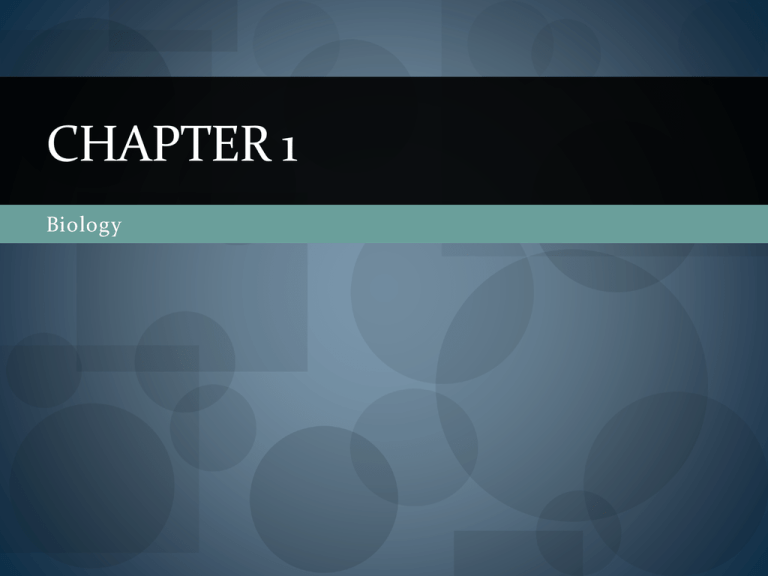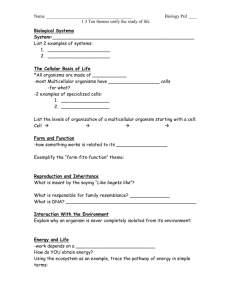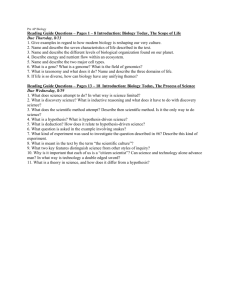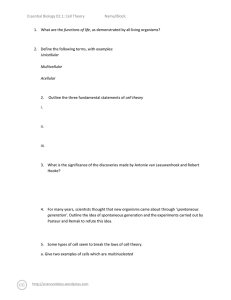Introduction to Biology / Life
advertisement

CHAPTER 1 Biology QUIZ 1. What is Biology? 2. What is Science? 3. What are the 4 branches of Science? ANSWERS Biologythe study of life ANSWERS ScienceWebster’s Dictionary- systematic knowledge of natural or physical phenomena; truth obtained by observation, experiment, and induction Winters’the study of why something occurs or exists What? How? Why? ANSWERS 4 branches of Science 1. 2. 3. 4. *Hopewell Curriculum Why do I need to know about Biology? We are living The more you know about biology, the more you will understand yourself. Diets (Adkins, Hollywood), pains (bees), foods Ask Questions???? Understand the world around you. Plastic? Tapioca? Nylon? Caviar? Jello? Pig intestines are used for what? How is Biology used in your everyday life? List examples and briefly explain. Feeding the dog- what to eat, amount, how often Toilet paper- gets the job done, breaks down in water Will Biologists answer all questions? We will never run out of questions. We are finding new organisms We will never cure all diseases or feed all people We do not have an endless supply of energy (oil) Living things must interact with environment Deer example: What might determine how many deer can live in an area? Characteristics of living things 1) Organization 2) Reproduction 3) Growth and Development 4) Adaptation 5) Homeostasis Organization Composed of one or more cells Reproduction Organisms must replace themselves Species- group of organisms that interbreed and produce fertile offspring Which animal cannot reproduce? Subspecies? Growth and Development Growth- increase in amount of living material Development- changes during life (mature) Adaptation Respond to a stimulus Stimulus- condition Response- reaction to a stimulus Examples: Eyes adjust to light Camels store water Homeostasis Regulation of internal environment (int. adaptation) Examples: Waste, salt, water, sugar, temperature, oxygen Organization Levels of Organization Atom Molecule Organelle Cell Tissue Organ Organ System Multicellular Organism Evolution Gradual change in a population of species over time in order to survive and compete for mates. Ex: Deer(brown/white), camo, lizards, man-eaters Are humans still evolving? 1.2 Methods in Biology Why does rain bring out worms? Why does moss grow on the north side of a tree? Which side of a mountain are most ski slopes? Scientific Methods Steps used to gather information and answer questions 1. 2. 3. 4. 5. Define Problem Hypothesis Experiment Analyze Data Report Results Define Problem What are you trying to answer? Observation- Information collected from the 5 senses Observation QUIZ! Hypothesis Testable explanation for a problem Not an opinion Often “if…then” statements Example: If batteries last longer, then that brand costs more money. Hypothesis- “Reasoning” Inductive Reasoning- using a fact and apply to all Ex: Mr. Allison Deductive Reasoning- use a general rule and apply to a specific case Ex: Doctor Experiment Testing a hypothesis under controlled conditions Control- condition kept the same Control Group? Independent variable- condition changed Dependent variable- measurement of the change in the ind. variable Data- information collected (# or description) Experiment examples Batteries Independent Variable , Dependent Var., Control Testing Shoes Weight-loss pills Placebo? Ginko Biloba Worksheet Scientific Method Analyzing Data: Did the experiment answer the problem? Is more experimenting needed? Reporting Results: Was your hypothesis correct? Why or why not? Show results (Chart and Graphs) Scientific Method Theory- explanation supported by scientific evidence Law- Fact of nature, cannot be disproven 1.3 The Nature of Biology Quantitative- results in numerical data - reported as tables or graphs - English / Customary vs. SI / Metric - based on ten, easy to convert Qualitative- results in observational data Ethics- moral principles or values Science is not good or bad Some applications may be viewed as good or bad Stem cell research, cloning, abortion, death penalty Stem cell link Stem cell link 2 Stem cell link 3 Science Pure Science - study carried out for the sake of knowledge - no immediate impact to humans Ex: Pluto being a planet Jellyfish glow in florescent light Science Technology - application of science to improve human life Ex: protein code to promote cells to grow hair increase food production reduce manual labor decrease pollution alternative sources of energy Is our technology allowing us to live too long?







